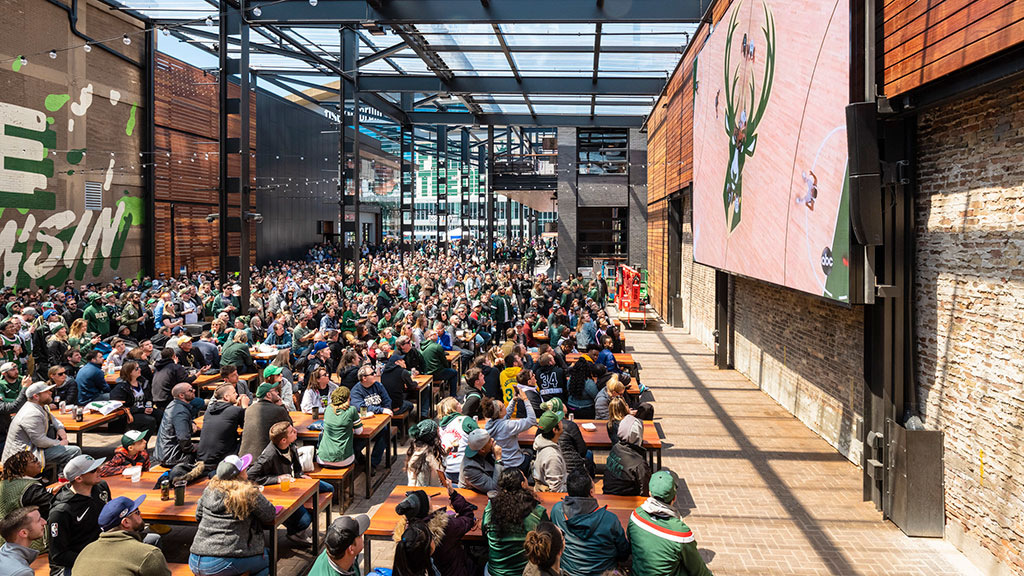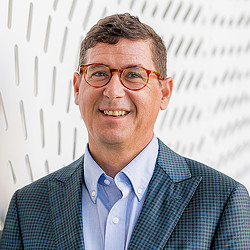The Future of Sports Venues Is About Creating Vibrant, Multiuse Districts
August 01, 2023 | Q&A with Jon Niemuth
While live sports events have rebounded to pre-pandemic levels, these venues are increasingly competing for attention with a proliferation of mobile devices, streaming content, e-sports, and home entertainment. To deepen connections with fans, attract new audiences, and increase ROI, sports organizations are looking for ways to boost year-round engagement. By activating venues and the experiences around them, sports and entertainment districts can generate new forms of revenue and help create 24/7 live-work-play communities.
We sat down with Jon Niemuth, director for Gensler Sports, to discuss what’s next for sports and entertainment venue design, and why these facilities should be closely integrated into the cities where they reside.
For many years, the trend with sports arenas has been moving away from single-use, game-day venues toward entertainment districts. How has that approach evolved?
Jon Niemuth: Today, for sports development, it’s not always about design. It’s design and urban planning. It’s design and operations. It’s design and revenue generation. It’s design and multipurpose flexibility. It’s always “design, and….” Gensler does commercial real estate and sports; housing and high density residential and sports; and commercial, urban planning, strategy, innovation, and sports. We are better aligned to meet the demands and expectations of our clients’ evolving needs.
A great example is what the Chicago Cubs have done in and around Wrigley Field. They made targeted enhancements inside and outside the ballpark with new housing, new commercial spaces, and new amenities. They transformed what has been for years an organic collection and made the idea of “Wrigleyville” an integrated hub within Chicago. It’s now a cohesive district, a destination for more than baseball, and a true live-work-play center within the larger city. For years, Cubs fans made the pilgrimage for games but now, even when the stadium is empty, Wrigleyville is a must-see destination for a concert or to have dinner. As we have seen this summer with Taylor Swift’s Eras tour, there is as much energy and activity outside of stadiums as inside. Fans flock to just hear the distant sound, and to be part of the larger experience. And because they’re part of that experience, they’re going to the bars and restaurants.
It’s not about sports so much anymore as the experience. It’s culture and sports, or sports and food, or sports and music, culture, and housing.
How have sports team owners’ approach evolved to focus beyond ticket sales and the venue?
JN: Over the last 40 years, we’ve had generational owners. Now, you’re seeing owners who are businesspeople like Stephen Ross, founder of Related Companies, who owns the Miami Dolphins, or Dan Gilbert, owner of Rocket Mortgage, who owns the Cleveland Cavaliers. They’re activating around these sports properties because for them it’s about a lifestyle. The basketball arena can activate a transit node, which then activates and increases the development potential of real estate around it. A stadium can be a destination for global events like Formula 1 (F1) or World Tennis Tour.
We’re seeing the same thing in colleges now too. At Baylor, a public/private sports program development has boosted the school athletically and academically as they’ve grown the footprint of their campus with a venue that engages the larger community of Waco as a civic asset.
Stadiums are getting smaller. But it’s not necessarily because we’re not focused on seats. We’re designing the full experience, from the outside in. Can you talk about how, in designing a venue, the city implication comes into play?
JN: Thirty years ago, going to a sporting event was about going to the ballpark, the arena, or the stadium, and that was the end-all, be-all of your experience. Back then, venue owners wanted you to get you in the gate as early as possible and extract as much money from your pockets while you were inside the ticketed zone.
Today, that has shifted. People who are going to a venue like L.A. LIVE to see a Lakers game are going early to have coffee, go to the museum, and then watch the Lakers play, and grab a drink or dinner afterwards. So, it’s less about getting people in the arena for a game. The longer they can get people to that district, the more it becomes part of their lifestyle, and they’ll go back again.
How can sports venues better appeal to avid fans, as well as casual fans, or not fans?
JN: What’s interesting about the role of the designer in the evolving landscape of sports and entertainment and urban revitalization is the push to get cities to rediscover themselves. By activating venues and the experiences around them, we are creating urban neighborhoods that should appeal to every kind of fan or person even if they aren’t a fan. Sometimes the focus shouldn’t even be on the arena. It might be the public space that the arena opens up to. There’s been live music in the plaza at L.A. LIVE. In Sacramento, they do a lot of outdoor concert events, farmer’s markets, and art festivals. Petco Park in San Diego is another great example. It’s not the sports. It’s the “and entertainment, and residential, and urban economics.” It’s the “and...” that will make sports venues more appealing.
What challenges and opportunities are next for the future of sports venues and districts?
JN: Over the last few decades, we have seen teams begin to move away from shared facilities to more dedicated team facilities aligned to the specific qualities of their sport, economics, location, etc. Larger cities and regions have been able to absorb this in part with an expansion in the demand for live entertainment and an ever-more-crowded event calendar.
What will change in the near future is the question, how many sport districts are enough? Is there a saturation point for cities, where these destination developments may begin to intersect?
We are already seeing examples of sprawl as teams seek out locations that are further away from urban centers to create the same quality of experiences. Balancing these lifestyle goals with a need to focus on density and regeneration in our cities will be a challenge for designers and planners.
We see ample opportunity for team owners, developers, and planners to focus on infill concepts in the urban core. Strategic development with targeted adaptive reuse or replacement can allow existing urban assets to remain in place while we reinvigorate the context around them. Los Angeles, Chicago, and Boston are good examples of cities where projects have struck this balance around single entity destinations. Locations such as Cleveland and Detroit, where multiple large-scale venues and owners exist in close proximity, create the opportunity for co-development and collaboration.
Regardless of the location or the situation, the objective is the same. Our goal is to create vibrant but sustainable developments that are supportive of both the interior and exterior goals of our sport and entertainment venues. The challenge for venue designers like us is to strike the right balance across a spectrum of demands.
For media inquiries, email .

